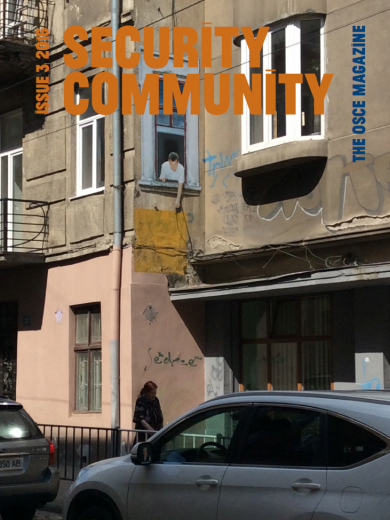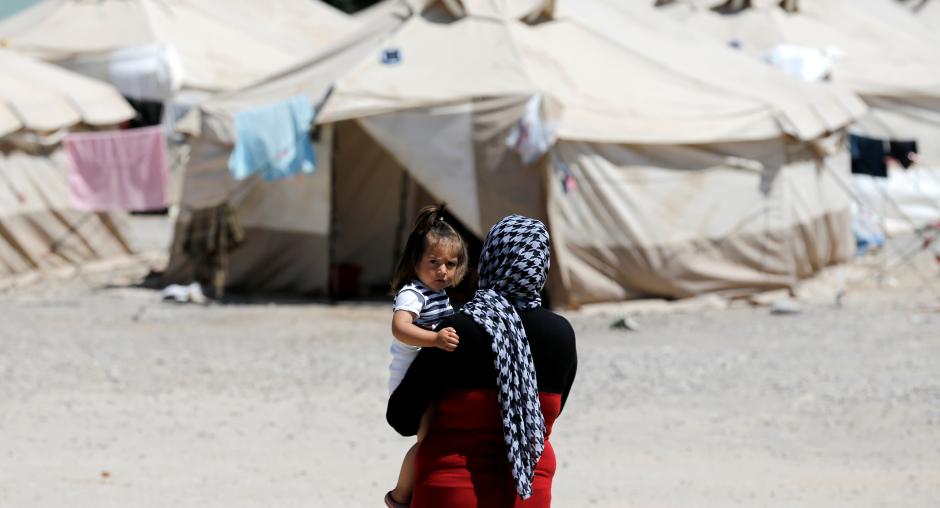A Systemic Part of Conflict
By Gulnara Shahinian
"No one leaves home unless home is the mouth of a shark."
– Warsan Shire, Teaching my Mother How to Give Birth
For months and years, hardly a day has passed without news of inhuman hardship suffered by people in war-torn regions, of desperate voyages in search of safety that end in exploitation or death. The heart-breaking stories and photos have not left us indifferent. But they continue to come and the figures are numbing: over 60 million people worldwide uprooted from their homes according to the UN High Commissioner for Refugees, thousands of people drowned in the Mediterranean Sea. We look for signs of improvement – in vain. Recent studies in zones of conflict and along migration routes tell us instead that the human exploitation, the trafficking and the enslavement that accompany conflict and war like an inseparable shadow are taking on new proportions, intensifying and diversifying.
In countries where conflict rages, trafficking of women, children and men takes many forms: sexual exploitation, forced labour, enlistment into armed and terrorist groups, exploitation for the drug and organ trade. Parents in their desire to protect their daughters from rape and sexual exploitation forcibly marry them: in Syria, early forced marriages are on an unprecedented rise. But for the majority, this survival strategy turns into domestic and sexual slavery – and often prostitution abroad.
The barbarity exercised by Daesh in Syria against the Yazidi people is appalling beyond belief. Survivors like the young Yazidi woman, Nadia Murad, who testified before the UN Security Council, tell of the systematic murder of Yazidi men and enslavement of Yazidi women, who are violently raped, forced to serve as sexual slaves to militants, sold at slave markets and terribly exploited and beaten. Yazidi girls who do not want to convert to Islam and become sexual slaves are burned alive. This slavery is being widely recognized as a crime against humanity.
Alarming Trends
Violence and trafficking are evolving in worrying ways. An International Organization for Migration (IOM) survey for the reporting period June to September 2016 shows that the hate-driven cruelty typical seen in early stages of a war – killing of men before the eyes of their families, enslavement of women, exploitation of children – is increasingly being augmented by the use of people as a throwaway resource to feed war-driven demands for organs and blood. Here the majority of victims are men. Labour exploitation remains rampant. People being smuggled out of the conflict zone are forced to donate organs or transport drugs such as Catagon as partial payment of passage.
Faced with the choice – which is a non-choice – between submitting to violence, cruelty and likely extermination and embarking on a risky journey of escape, people opt for the second, leaving behind their homes and life savings and agreeing to any conceivable conditions for the opportunity to bring themselves and their children to safety. Sadly, they become trapped in another tragic cycle, exposed to numerous risks at every stage of their journey. The IOM provides disturbing evidence based on data gathered from 9,000 migrants over the period of ten months in 2016 that more than 70 per cent of migrants arriving in Europe by boat are trafficked or exploited. Half of the respondents had been held against their will, often kidnapped for ransom, with forced labour without pay the only way to freedom. A December 2015 IOM report on human trafficking and exploitation in times of crisis mentions the disappearance of many migrant women and unaccompanied children, possibly for forced labour, sexual exploitation and other criminal purposes.
Unfortunately the tragic journey of these people does not finish upon reaching Europe. Many are not granted entitlement to international legal protection; poor identification practices and the restrictive policies of some states result in heightened vulnerability to trafficking and exploitation. Terre des Hommes has reported forced labour, including child labour, in refugee and asylum camps.
Seeking Durable Solutions
This disastrous situation is rooted in countless causes: extreme poverty and absence of opportunities for economic development; environmental degradation; vulnerability to crime and lack of protection due to protracted political crises and civil wars; violence and unseen brutalities committed against ethnic and religious groups by extremist organizations. Current conflicts seem to have very limited perspectives for resolution: a political settlement for the Syrian war remains out of sight and there is no clear international strategy for addressing the related conflict in Iraq. No stability has been achieved in Afghanistan, Somalia or Libya. Programmes and policies to address the chronic poverty, discrimination, failing governance, climate and environmental changes in many developing countries have also been inadequate. Crises are expected to multiply as all of the many problems that people are facing stay unresolved.
Further study and analysis is needed to fully determine the nature and extent of the trafficking and enslavement in conflict zones and migration routes. But the information we already have provides sufficient grounds to state that trafficking is not a side effect of conflict, it is a systemic part of it, and requires special attention from the very onset. The current humanitarian crisis is providing us with strong alarm signals. There is an urgent need to develop durable, innovative policy responses that put human security and dignity at the centre.
Early warning
We should be very attentive to early warning signals and be able to address them immediately through diplomacy and in development and humanitarian programmes. Prevention has to be rethought to address the cause of vulnerabilities. By strengthening prevention, we might be able to stop the process of death and destruction at its inception.
Protection
People fleeing conflict should receive special protection and support. There needs to be a strengthened human rights-based approach to the identification of people on the move and a consideration of everyone’s best interest in providing them with protection under the obligation of international law.
Research shows that the longer migrants spend in transit, the more likely they fall prey to criminal exploitation. To provide minimum security, it is necessary to strengthen the operation of European Union rescue teams and widen their geographic coverage.
Co-operation and co-ordination
Of all the magic words used to describe effective policies to fight human trafficking, these are the most important. Co-operation between countries of origin, transit and destination and among stakeholders in each country is crucial. A long-term and comprehensive strategy to tackle the causes and consequences of the current influx of migrants, adequate diplomatic and political efforts, improving and harmonizing asylum and resettlement systems are primary requirements.
Investment
Short-term and long-term investment and programmes that create viable opportunities for employment and economic development are needed in countries of exodus to promote peace and stability.
Analysis of root causes
Studies should be conducted on the nature and incidence of trafficking and enslavement in conflict and war zones. Root causes – indicators of trafficking and also of risks of trafficking – need to be studied, analysed and reflected in policies and laws. Otherwise, the wars, migration waves and environmental catastrophes that are driving today’s crisis will continue to be replicated and expand.
Standard asylum procedures
Countries of destination have to agree on standard asylum procedures that consider everyone’s best interest and ensure that the right to seek asylum as enshrined in the Universal Declaration of Human Rights and guaranteed in the European Union Charter of Fundamental Rights is upheld. Proper screening and identification should be provided. People fleeing conflict, victims of trafficking and slavery, women, children and other vulnerable groups require special attention.
Use of intellectual capital
The intellectual capital of refugees and asylum seeking should be used and enhanced as a resource both in the countries of asylum, lessening their burden and meeting their specific labour demands, and in the countries of exodus upon their return. Provided refugees, insofar as their potential allows, with job training in innovative market-oriented areas, which they can share with their country of origin, can be a good investment. In many countries to which I travelled in my capacity as UN Special Rapporteur, I witnessed situations of latent conflict in refugee camps where those with skills and education were not addressed at all. Effective use of human capital is invaluable for strengthening the protection and harmony in societies.
Today’s crisis is a human rights crisis and a strong test for the value system to which we all adhere. We need political co-operation based on shared universal values and strong will of the political leadership. Human lives and dignity, our most valuable good, are at stake and every effort should be made to move from conflict to a sustainable peace.
Gulnara Shahinian is former UN Special Rapporteur on contemporary forms of slavery, its causes and consequences.
Welcome to Security Community
Security Community is the OSCE’s online space for expert analysis and personal perspectives on security issues.
The views expressed in the articles are those of the authors and do not necessarily reflect the official position of the OSCE and its participating States.


